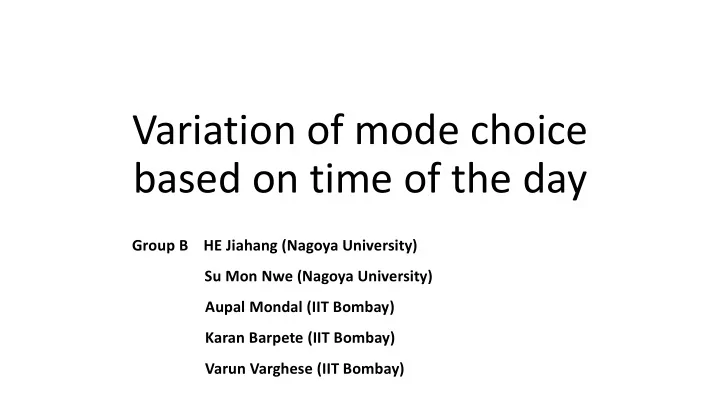

Variation of mode choice based on time of the day Group B HE Jiahang (Nagoya University) Su Mon Nwe (Nagoya University) Aupal Mondal (IIT Bombay) Karan Barpete (IIT Bombay) Varun Varghese (IIT Bombay)
Primary structure of the Mode choice model Mode Choice Non-active mode Active Mode Train Car Bus Walk Bicycle Why a Nested Logit Model based on Active and Non-active modes? • Travellers in general have a differentiated perception about modes that require physical activity ( active modes) from the non-active modes. • Characteristics of traveller may influence active and non-active mode choice . • Time of the day (peak/off-peak) and the purpose of the trip may affect the choice of active or non-active model of an individual.
Our original utility function of nested logit model. Nested function
We calculate the scale parameter at first
And we got the answer of scale parameter as 1.01, which is very close to 1.
So we set the scale parameter as 1, then the model became a multinomial logit model.
Nested logit model Multinomial logit model
Original nested logit Multinomial logit model model
Nested logit model According to our model, it means if the travel time increase, the Peak or Non peak possibility of choosing the explanatory variable alternative is decreasing. Multinomial logit model
Elasticity based on distance Distance DE_bike_time DE_walk_time DE_car_time DE_bus_time DE_train_time Less than Mean -.42 -.63 -.56 -.12 -.74 1km N 334.00 334.00 334.00 334.00 334.00 Std. .17 .28 .30 .16 1.06 Deviation 1km-3km Mean -1.18 -1.97 -1.13 -.41 -1.87 N 342.00 342.00 342.00 342.00 342.00 Std. .36 .66 .35 .56 1.07 Deviation 3km-5km Mean -2.63 -4.22 -1.87 -.41 -2.61 N 115.00 115.00 115.00 115.00 115.00 Std. .48 .89 .47 .90 1.20 Deviation 5km-10km Mean -5.07 -7.03 -2.73 -.07 -2.41 N 120.00 120.00 120.00 120.00 120.00 Std. 1.02 1.31 .56 .48 1.04 Deviation Gretear Mean -14.62 -12.41 -6.41 -.08 -6.09 than 10km N 611.00 611.00 611.00 611.00 611.00 Std. 6.29 2.63 2.43 .46 3.00 Deviation Total Mean -6.83 -6.44 -3.31 -.19 -3.42 N 1522.00 1522.00 1522.00 1522.00 1522.00 Std. 7.63 5.45 3.04 .51 3.07 Deviation
Cross Elasticity Wavg_bike Wavg_walk Wavg_car Wavg_bus Wavg_train Distance a) less than 1 0.06 0.71 0.21 0.17 1.95 km 0.11 1.19 0.15 0.17 2.2 b) 1km-3km 0.22 2.85 0.19 0.12 2.88 c) 3km-5km 0.33 6.42 0.14 0.15 1.9 d) 5km-10km e) Greater than 0.35 26.95 0.21 0.08 2.82 10km
Conclusion • MNL structure most appropriate for the model • Variation in elasticities plotted based on distance and spatially • Elasticities increase with increasing distance for all modes. • Spatial variation in elasticity for modes can be used for targeted policies in designated areas.
Thank You
Recommend
More recommend